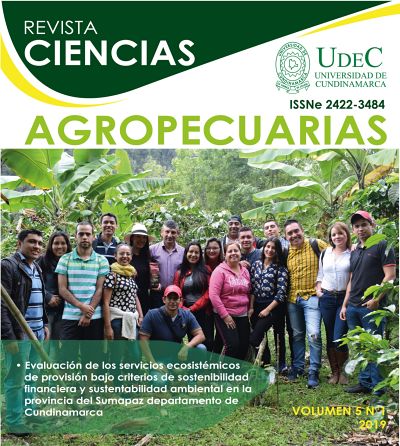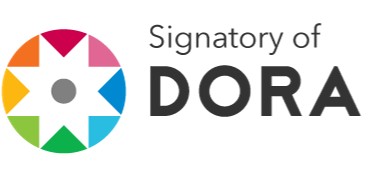Characterization of phytopathogenic diseases in tree tomato (Solanum betaceum) crops at the El Repos farm in the municipality of Facatativá, Cundinamarca.
DOI:
https://doi.org/10.36436/24223484.192Keywords:
Tomate de árbol, microorganismos, patógenos, incidencia, severidad, control.Abstract
Tree tomato (Solanum betaceum) cultivation is one of the most important crops in cold climates. This fruit crop enjoys high demand both domestically and internationally, as it possesses a high nutritional value. One of the main limitations of this crop are pathogenic diseases and nutritional deficiencies, which occur in the leaves and fruit, decreasing the photosynthetic capacity of the leaf and impairing fruit quality (size, color, and texture). With this in mind, the objective of this research was to evaluate the incidence and severity of these diseases, and also to characterize the causative agents in tree tomato cultivation in order to recommend a control method. The research was carried out on the Reposo farm located in the La Tribuna area, Facatativá municipality, which has a productive plantation of 150 plants. Two visits were made, the first to prepare a diagnosis and establish a sampling system, the second a sampling was carried out to take data (diseased plants, number of diseased leaves per tree and diseased area per leaf), additionally leaf samples were collected. Subsequently, in the laboratory, the pertinent tests were carried out for the characterization of the causal agents, for the identification of fungi the lactophenol blue staining technique was used, for bacteria the gran staining technique was carried out and for nematodes the Baermann method was performed. The results showed the presence of nematodes and pathogens such as Alternaria sp. and Colletotrichum sp., characterized as the causal agents of primary and secondary diseases. In addition, a high incidence was found in the crop but a low severity, which allowed management with copper oxychloride to be established, in order to keep the young leaves healthy and to be able to take care of the crop until its productive end.Downloads
References
Aranzazu, L., & Rondón, J. (1999). Manejo productivo del cultivo de tomate de árbol y de la antracnosis. Bogotá: Corpoica.
Berrio, C. (2014). cipaisafruits. Obtenido de http://cipaisafruits.blogspot.com/p/enfermedades-en-los-cultivos-de-tomate.html
Calvo Villegas, I. (2009). Cultivo de tomate de árbol (Cyphomandra betaceae). San José: ICE. Cámara de comercio de Bogotá. (2015). Manual de tomate de árbol. Bogotá: Cámara de comercio de Bogotá.
Cámara de comercio de Bogotá. (2015). Tomate de árbol. Bogotá: Cámara de comercio de Bogotá.
Chilpa, R. R., & Diago, O. L. (1993). Tomate De Árbol. México: Grupo etnobotánico Latinoamericano.
Díaz, A. A. (2009). Alternativa natural para el control de alternaria. México: Centro de investigación científica de Yucatán.
Feican, C. G. (2016). Descripción agronómica del cultivo de tomate de árbol (Solanum betaceum Cav.). México.8. Pérez, C. A., & Hoyos, S. P. (2011). Centro de pensamiento en estrategias competitivas - CEPEC. Bogotá: Universidad del Rosario.
Posada, L. F. (2006). Cultivo de Tomate de Árbol. Colombia: engormix.
Reyes, R., Mesa, J., Suárez, A., & Morales, C. (2006). Desarrollo de la Fruticultura en Cundinamarca. Bogotá: Feriva S.A.
Sembrar100. (2019). Oxicloruro de Cobre. Sembrar100.
Vargas, C. C., Bolaños, V., & Cruz, M. (2015). Estudio de las posibilidades agroindustriales del tomate de árbol (Solanum betaceum Cav.). Ecuador. INIAP.
Villegas, I. C. (2009). Cultivo de tomate de árbol (Cyphomandra betaceae). Costa Rica: INIA.
Tamayo, M., & Pablo, J. (2001). Principales enfermedades del tomate de árbol, la mora y el lulo en Colombia.
Saldarriaga, C., Bernal, E., & Tamayo, M. (2000). Reconocimiento y manejo de las enfermedades del cultivo del tomate de árbol en Antioquia.
Saldarriaga-Cardona, A., Castaño-Zapata, J., & Arango-Isaza, R. (2008). Caracterización del agente causante de la antracnosis en tomate de árbol, manzano y mora. Rev. Academia Colombiana de Ciencias Exactas, Físicas y Naturales, 32(123), 145-156.
Rondón, C., & Guillermo, J. (1998). Estudio biológico y epidemiológico de la antracnosis (Colletotrichum gloeosporioides, Penz), del tomate de árbol (Solanum betacea,(Cav) Sendt), y generación de alternativas para su manejo integrado en Colombia.
Gañán, L., Álvarez, E., & Zapata, J. C. (2015). Identificación genética de aislamientos de Colletotrichum spp. causantes de antracnosis en frutos de aguacate, banano, mango y tomate de árbol. Revista de la Academia Colombiana de Ciencias Exactas, Físicas y Naturales, 39(152), 339-347.
Downloads
Published
How to Cite
Issue
Section
License
Copyright (c) 2019 REVISTA CIENCIAS AGROPECUARIAS

This work is licensed under a Creative Commons Attribution-NonCommercial-NoDerivatives 4.0 International License.







